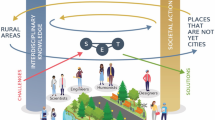Abstract
In polar areas, normal techniques must often be modified at additional costs in construction and maintenance of railroads, buildings, water and sewer lines, oil and gas pipelines, dams, roads, bridges, and airfields because of permafrost. But despite problems unique to the cold regions, development of the permafrost areas will continue at an ever-increasing rate. Humans have already learned to cope with many of the problems, and future improvements in scientific and engineering approaches, plus careful geological site selection and further study of the permafrost problem, will allow successful expansion into polar areas.
Similar content being viewed by others
References
Are, F.E.: Subsea cryolithozone of the Arctic ocean. Draft Translation No. 686, US Army, Cold Regions Research and Engineering Laboratory, Hanover, New Hampshire, 26 pp, 1978.
Lachenbruch, A.H., and Marshall, B.V.: Sub-sea temperatures and a simple tentative model for offshore permafrost at Prudhoe Bay, Alaska US Geological Survey, File Report 77–395, 54 pp, 1977.
Hunter, J.A.M. and Judge, A.S., MacCauley, H.A., Good, R.L., Gagne, R.M., and Burns, R.A.: Permafrost and frozen subsea bottom materials in the southern Beaufort Sea. Beaufort Sea Technical Report No. 22, Department of Energy, Mines and Resources, Canada, 173 pp., 1976.
Brown, R.J.E: Permafrost map. In: Hydrological Atlas of Canada. Dept. of Fisheries and Environ. Ottawa, Canada 1978.
Gravis, G.F., Zabolotnik. S.I., Lisun, A.M. und Sukhodrovskii, V.L.: The geocrylogical characteristics of the Mongolian Peoples' Republic and some characteristics of permafrost development in the past. In: Permafrost Translation of the USSR contribution to the Second International Conference, Nat. Acad. Sci., Wash., D.C., 81–85, 1978.
Hopkins, D.M. et.al.: Earth Science studies. In: Beaufort Sea synthesis report. Arctic Proj. Bull., NOAA, Univ. of Alaska 43 72, 1977.
Hunter, J.A.M., Judge, A.S., MacAulay, H.A., Good, R.L., Gagne, R.M., and R.A. Burns: Permafrost and frozen sub-sea bottom materials in the southern Beaufort Sea. Beaufort Sea Proj. Rept. No. 22, Dept. of the Environ., Canada, 174 pp., 1976.
Karpov, V.M., and Puzanov, I.I.: Construction and permafrost. Popular science series, Leningrad, Publisher for literature on construction, 94 pp., 1970.
Liestøl, O.: Pingos, springs and permafrost in Spitsbergen: Norsk Polarinstitutt Yearbook, 1975, Oslo, 7–29, 1977.
Priesnitz, K. and Schunke, E.: An approach to the ecology of permafrost in central Iceland. Proc. Third Internat. Conf. Permafrost, Edmonton, 1, 1978.
Rapp, A., and Annesten, L.: Permafrost and tundra polygons in Northern Sweden. In: The periglacial environment — past and present. Péwé, T.L., ed., pp. 65–91, Montreal, McGill Univ. Press, 1969.
Weidick, A.: Observations on some Holocene glacier fluctuations in west Greenland. Meddel. om Grønland, 165, 6, 1–202 (1968)
Author information
Authors and Affiliations
Rights and permissions
About this article
Cite this article
Péwé, T.L. Permafrost — and its affects on human activities in arctic and subarctic regions. GeoJournal 3, 333–344 (1979). https://doi.org/10.1007/BF00221235
Issue Date:
DOI: https://doi.org/10.1007/BF00221235




